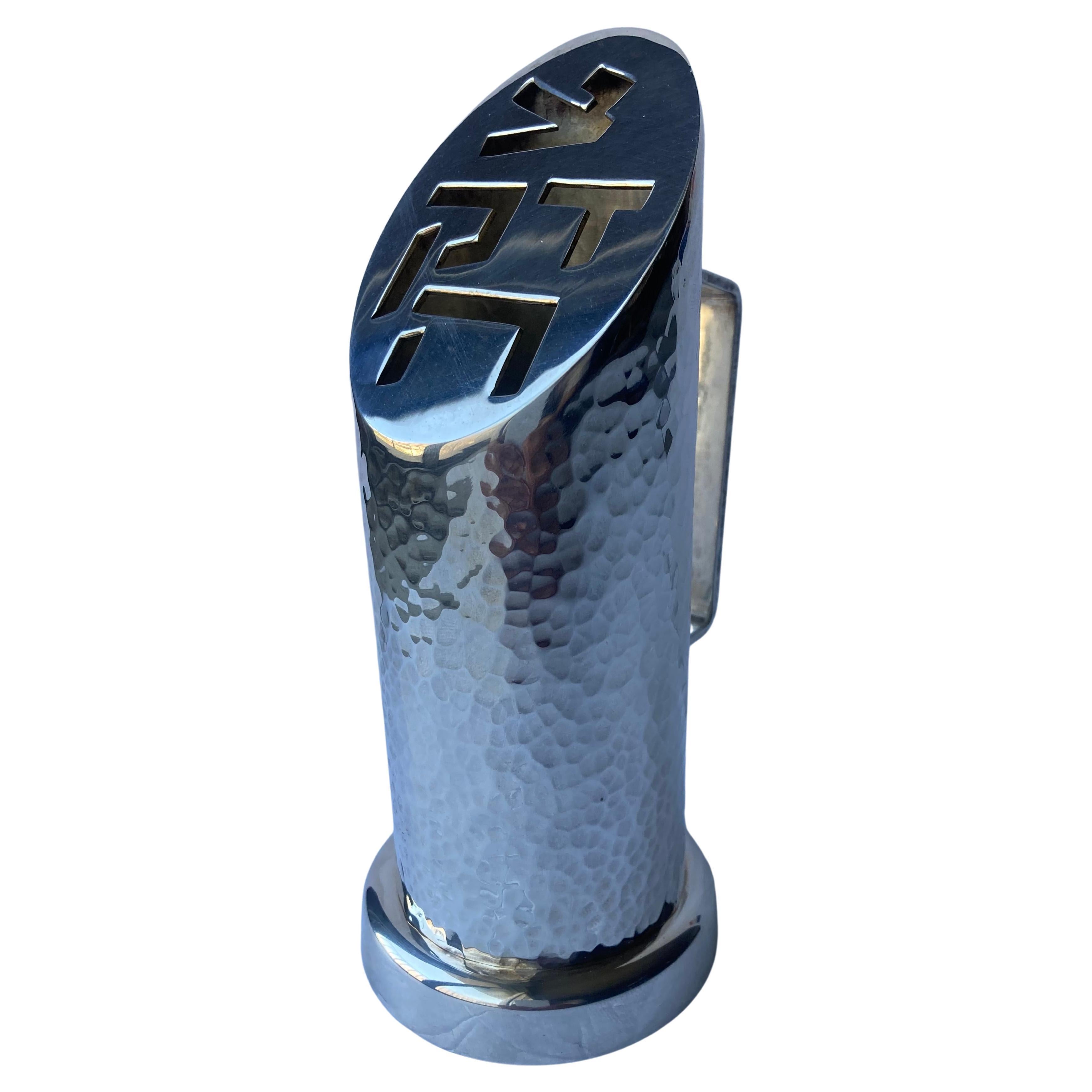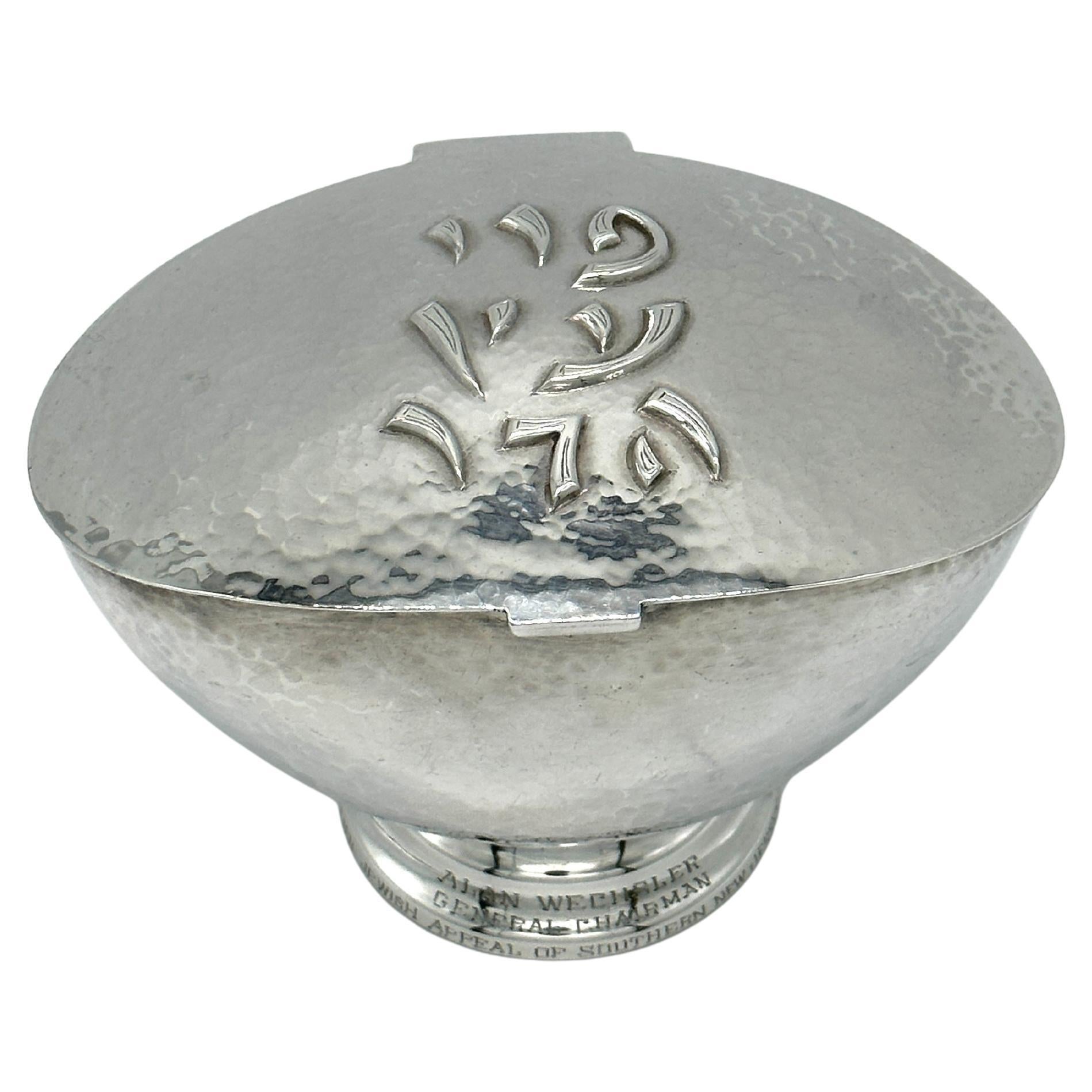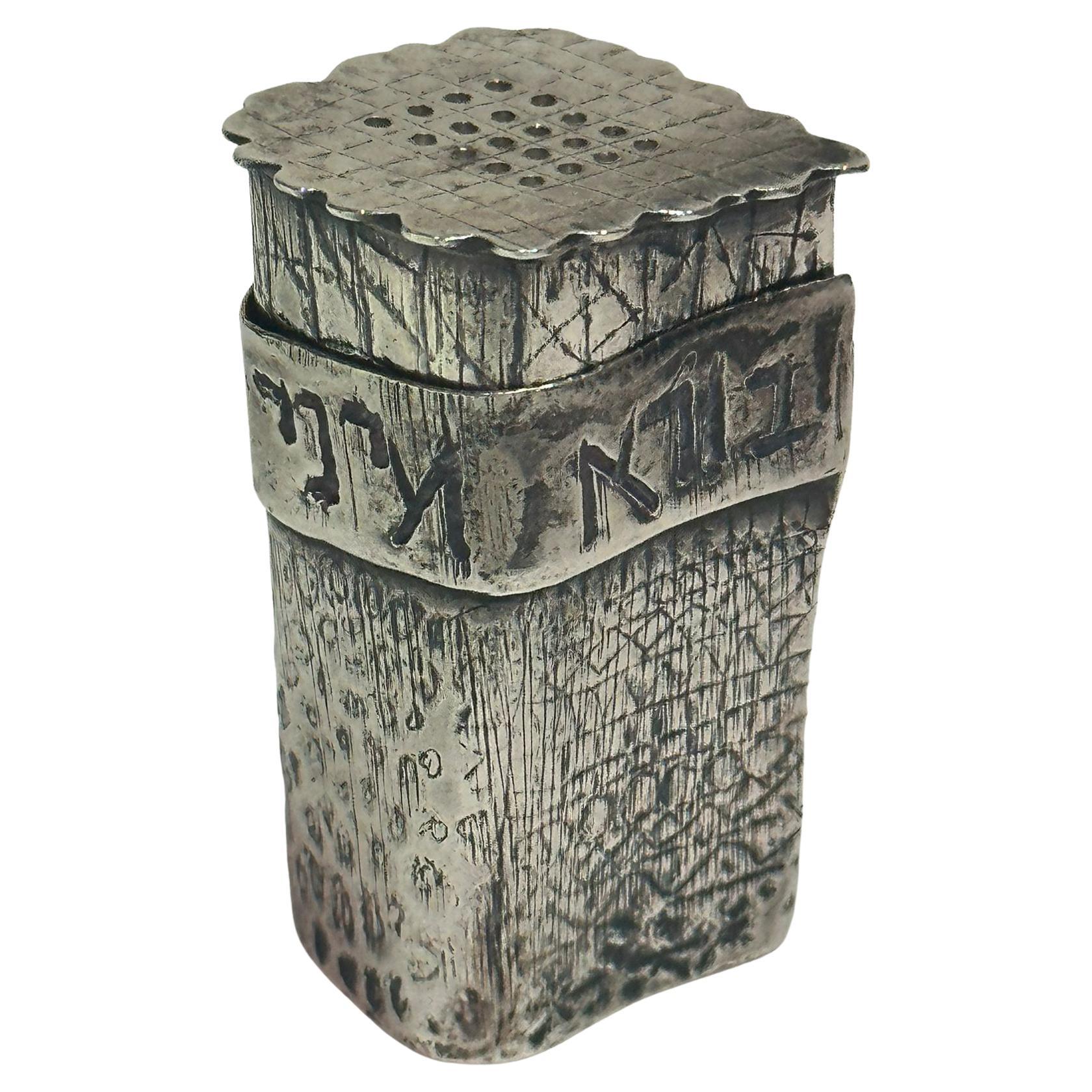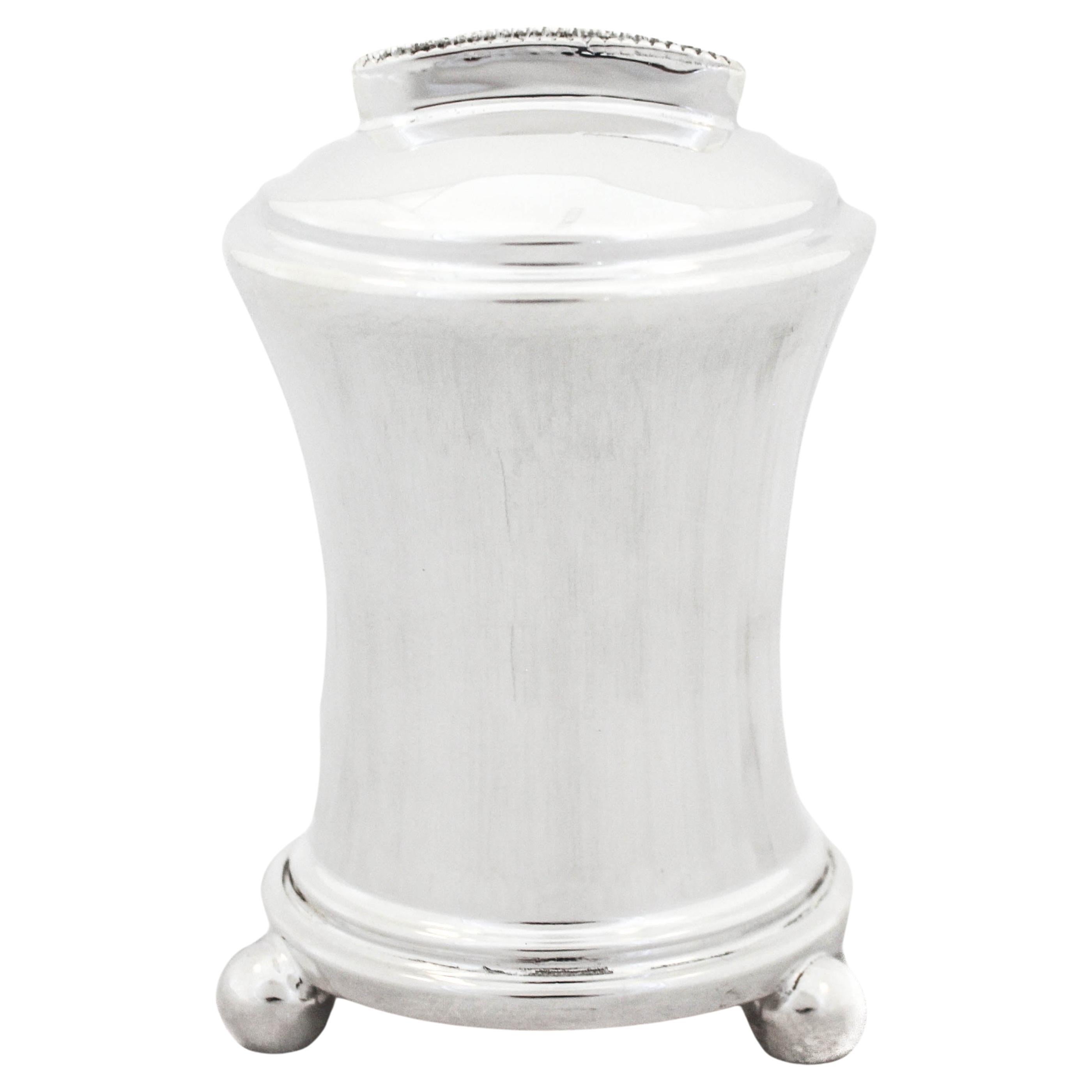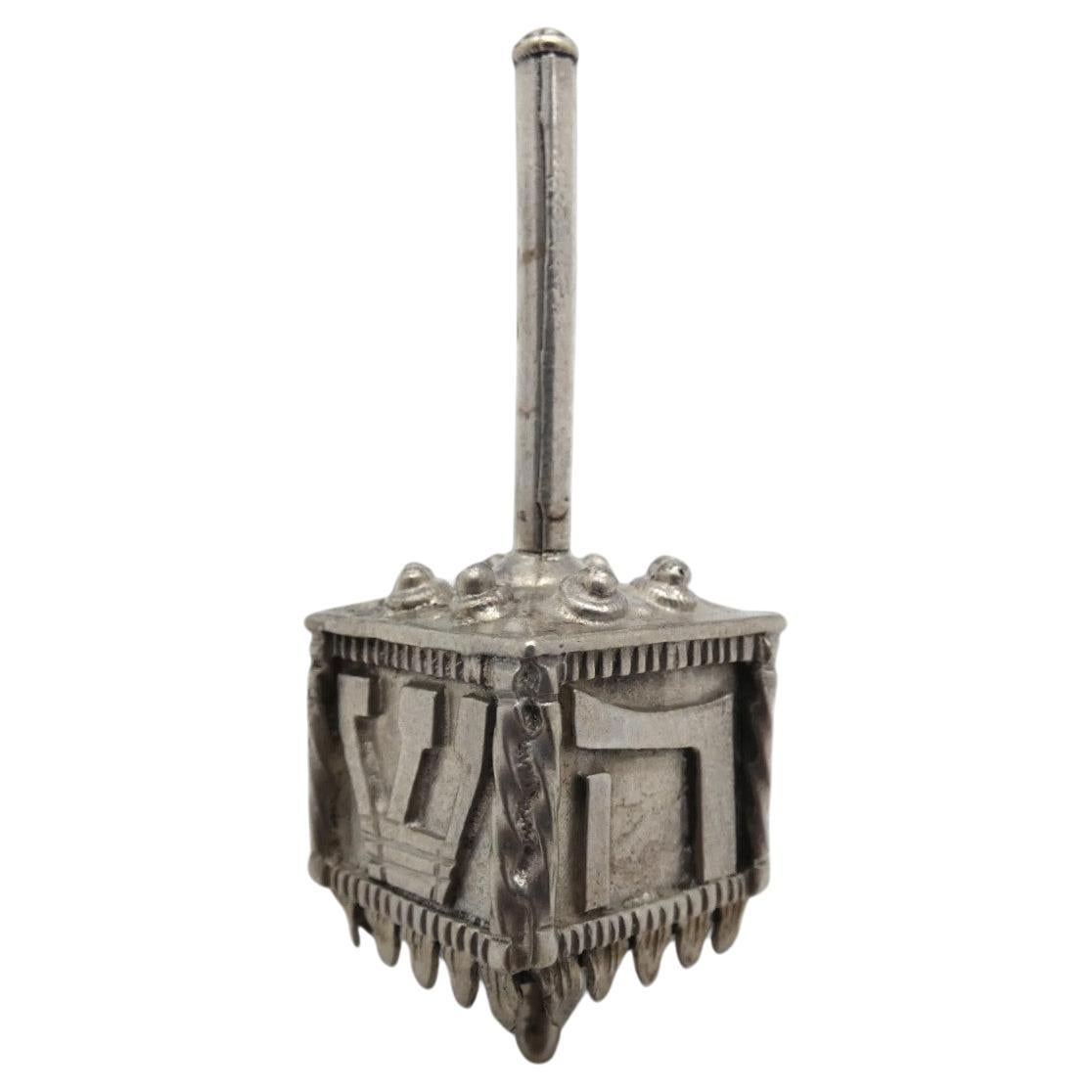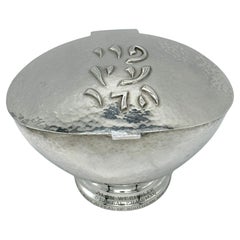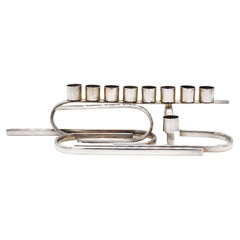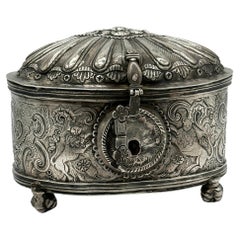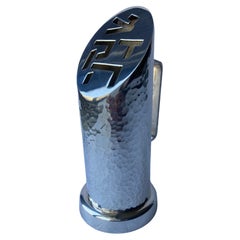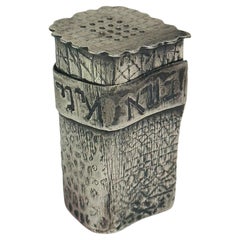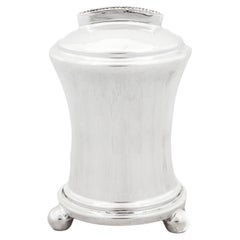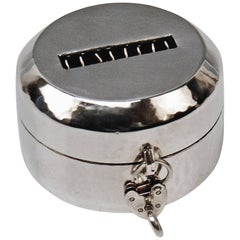Items Similar to An Israeli sterling Silver Tzedakah box, Judaica, by Carmel Shabi, 1994
Want more images or videos?
Request additional images or videos from the seller
1 of 7
An Israeli sterling Silver Tzedakah box, Judaica, by Carmel Shabi, 1994
$9,000
£6,880.98
€7,925.50
CA$12,611.76
A$14,079.84
CHF 7,377.63
MX$172,351.10
NOK 93,695.93
SEK 88,343.36
DKK 59,148.81
Shipping
Retrieving quote...The 1stDibs Promise:
Authenticity Guarantee,
Money-Back Guarantee,
24-Hour Cancellation
About the Item
Tzedakah box of flattened oviform shape (round fish shape) , amazing sleek and Modernistic design. just a masterpiece of design.
Pierced with stylized Hebrew words for Charity or "צדקה" , also pierced with a Cylindrical aperture to form a handle , the base with small hinged panel opened to Remove the coins that are inserted to the top, inside the cut out latter "ד" in hebrew, The surface lightly textured with wriggelwork all over, signed on base with Monogram, Hebrew date for 1994, Menorah, Israel and 925.
Carmel Dhabi is a well known famous silversmith, learned in the United kingdom And started to make fabulous Judaica objects once he came back to Israel in the 80s'.
- Dimensions:Height: 4.7 in (11.94 cm)Width: 5.5 in (13.97 cm)Depth: 3.7 in (9.4 cm)
- Materials and Techniques:
- Period:1990-1999
- Date of Manufacture:1994
- Condition:PARFECT ORIGINAL CONDITION.
- Seller Location:Tel Aviv - Jaffa, IL
- Reference Number:1stDibs: LU8130237681182
About the Seller
No Reviews Yet
Vetted Professional Seller
Every seller passes strict standards for authenticity and reliability
1stDibs seller since 2023
- ShippingRetrieving quote...Shipping from: Tel Aviv - Jaffa, Israel
- Return Policy
Authenticity Guarantee
In the unlikely event there’s an issue with an item’s authenticity, contact us within 1 year for a full refund. DetailsMoney-Back Guarantee
If your item is not as described, is damaged in transit, or does not arrive, contact us within 7 days for a full refund. Details24-Hour Cancellation
You have a 24-hour grace period in which to reconsider your purchase, with no questions asked.Vetted Professional Sellers
Our world-class sellers must adhere to strict standards for service and quality, maintaining the integrity of our listings.Price-Match Guarantee
If you find that a seller listed the same item for a lower price elsewhere, we’ll match it.Trusted Global Delivery
Our best-in-class carrier network provides specialized shipping options worldwide, including custom delivery.More From This Seller
View AllJUDAICA SILVER ETROG BOX DESIGNED BY LUDWIG WOLPERT. New York, 20th century
Located in Tel Aviv - Jaffa, IL
This charming piece of jewish history in front of you is a one of kind modern Judaica object,
This box used to hold the Etrog To protect the it during the holiday of Sukkot, it is traditionally Wrapped in silky flax fibers and stored in a special decorative box, mostly made from silver.
Wolpert designed this amazing hand hammered Bauhaus style box in 1963-1964 while he was Working in New York. all of the boxes we could found from this design made by Wolpert have The upper part inscribed in a simple engraving with the phrase "Pri Etz Hadar"
In Hebrew ״פרי עץ הדר״. the box in front of you is the only example in existence as far as we Know where the letters are also repoussé and also engraved, such a beautiful and hard to get Combination, the rest of the box is shaped as a modernistic Etrog, all the body of the box is Skillfully hand hammered in a way it reflects the light in a warm and calm way, a true Masterpiece of modern judaica by the great and important artist Ludwig Yehuda Wolpert.
One of the the two great masters of 20th century Judaica.
the Box is marked "WOLPERT" AND "STERLING" and the base has the engraved inscription :
"ALAN WECHSLER GENERAL CHAIRMAN, ALLIED JEWISH APPEAL OF SOUTHERN NEW JERSEY 1978"
Similar boxes can be find in museum collections around the world
In the Jewish Museum New York
In the North Carolina Museum of Art
In The Derfner Judaica Museum
Another similar box was featured in the Israel Museum exhibition
"Forging Ahead, Wolpert and Gumbel, Israeli Silversmiths for the Modern Age"
Ludwig Yehuda Wolpert was born in Hildesheim, Germany, to an Orthodox family. In 1916-1920, He began his studies in sculpture at the Frankfurt School of Art. In 1925-1928, he studied Goldsmithing at the Frankfurt School of Art.
Following the presentation of the works in the 1930 exhibition "Kult und Form" ("Ritual and Form") at the Jewish Museum in Berlin, his works became well known in the German Jewish World. His works were greatly influenced by Modernist design, especially the Bauhaus Movement. Wolpert's works avoid decoration, relying on clean, geometric shapes. In 1933, Following the Nazi rise to power in Germany, he immigrated to the Mandatory Palestine with His family. There he worked for two years in the workshop of Bernhard Friedländer, where he Designed and produced silverware and Jewish ceremonial art.Together with Victor Solomon...
Category
Vintage 1960s Decorative Boxes
Materials
Silver
extremely rare Algerian Judaica silver, jewish Dowry box early 19th century
Located in Tel Aviv - Jaffa, IL
Amazing and scarce JUDAICA object, we have here one of the most touching jewish objects we had for a long time, this small silver dowry box was made in Algeria in the early 19th century, it is all covered with symbols of jewish faith and of couples, the sliding lid has 2 flanking birds with hamsa (protective hand) on each side and a flower vase in the middle.
one side shows two flanking lions with a tree in the middle and the other side shows again two big and two small birds with a flower bowl in the middle, front side has a key hole and next to it there is the Hebrew inscription ס״ט״" which says Siman tov or in English "a good sign" it is taken from the wedding blessing, underneath the lock there is another inscription with the name ״עזיזה בת אברהם בן חמו״ which is the name of the bride, her father and her grandfathers name.
the box is full marked a lot of times with the silversmith mark, every side of the box is marked.
this box was probably ordered by the grooms family to hold the jewelry they are giving to the bride as dowry, this type of objects are rare and there are just a few of them on museum collections.
DOWRY (Heb. נְדֻנְיָה), the property a wife brings to her husband at marriage; the Yiddish equivalent, nadn, is from the same root. The custom of nedunyah became clearly defined and institutionalized only in the talmudic period. In biblical times, mohar (מֹהַר), whereby the groom bought his wife from her father (Gen. 24:53; Ex. 22:15–16; Hos. 3:2), was the accepted practice. It was then customary that the groom give the bride gifts, and that she bring certain property to her husband's home upon marriage: slaves, cattle, real estate, etc. (cf. Gen. 24:59–61; 29; Judg. 1:14ff.; I Kings 9:16). Evidence of the custom of nedunyah is to be found in Tobit (7:14; 8:21) and in the Assuan papyri (Cowley, Aramaic, nos. 15, 18). Gradually, mohar was superseded by the ketubbah custom according to which the husband merely assumed the responsibility of compensation to his wife in case he divorced her: he had to pay her 200 zuzim if she had been a virgin at the time of marriage, and 100 zuzim if a widow or divorcée (see *Ketubbah).
By talmudic times, the institution of nedunyah was prevalent; the father gave a dowry to the bride since the daughter was excluded from paternal inheritance. Fifty zuzim (equivalent to the worth of 180 grams of silver) was the minimum amount a father was obliged to give to his daughter (Ket. 6:5). Parents usually gave much more, according to their social standing. Community funds provided the dowry for an orphan or a very poor girl (ibid.; cf. Sh. Ar., YD 251:8). In case of her father's death, the brothers of a minor girl were obliged to give her the minimum dowry, and the court estimated how much her father would have given her above the minimum dowry. The sum was then taken out of the father's estate and given to the daughter upon majority (Ket. 6:6; 68a–69b). In the absence of such an estimate, each daughter was entitled to receive one-tenth of the value of her father's estate in money, or in valuables (Yad, Ishut, 20:4–7; Sh. Ar., EH 113:4). If the father was unable or unwilling to pay the promised dowry at the betrothal ceremony, the groom could refuse to marry his bride (Ket. 13:5; Ket. 108b–109a). Insistence on exact payment of the promised dowry, however, was frowned upon by later rabbinic authorities (Rema to Sh. Ar., EH 2:1). In certain communities it was customary for the groom's father to make a dowry contribution equal to that of the bride's father (Ket. 102b). The dowry, whether given in real estate, slaves, money, or chattel was recorded in the marriage contract (the ketubbah) and in some instances one-third or one-fifth of the actual value of the dowry was added to the sum mentioned in the ketubbah. Based upon a decree enacted by *Simeon b. Shetah (first century C.E.), the Talmud ruled that the husband and his entire property were liable for compensation as stipulated in the ketubbah, either in case he died (when she collected the sum specified in the ketubbah from the heirs) or in case he divorced his wife (Ket. 82b). For the status of the dowry and the husband's rights and obligations, see below. The rabbinic enactments (Takkanot Shum) by R. Jacob *Tam and by the rabbinic synod of the communities of Speyer, Worms, and Mainz (Germany) stipulated that if a woman died...
Category
Antique Mid-19th Century Algerian Tribal Art
Materials
Silver
Silver Hanukkah Lamp made by Eli Gera, modern Judaica, Israel, Tel Aviv 1970s.
Located in Tel Aviv - Jaffa, IL
Very rare and important piece of Israeli modern Judaica, a bauhaus style silver Hanukkah Lamp made by the famous jewish silversmith Eli Gera, made from hand bent And hand Forged silver in the 70s, while other works by Gera were multiplied by him, from What we Know this piece is a one of a kind.
Marked "SILVER 925" and ELI GERA in Hebrew and English
on a small silver plaque on the base.
Measurements:
Height: 3 inch / 7.6 cm
Width: 11.8 inch / 30 cm
Depth : 3.3 inch / 8.5 cm
Condition :
Perfect condition for its age, no brakes, no restorations, some minor scratches and age Related wear
About the artist :
Please note the Victoria & Albert Museum in London holds an Hanukkah lamp Havdalah Set...
Category
Vintage 1970s Israeli Bauhaus Sterling Silver
Materials
Silver
Rare silver Herb Box (Yerbera), Upper Peru, Potosí, c. 1775–90 great repoussé
Located in Tel Aviv - Jaffa, IL
Herb Box (Yerbera), Upper Peru, possibly Potosí, c. 1775–90, cast, repoussé, and chased silver,
the design is very intricate, with lions, cats and some other animals, and a women on the lid, it is made in a shell shape with a classical women on top of the lid, the body is all hand made with lions and wild cats with leafs designs, the inner part is divided into two compartments, as usually in this type of boxes. lock is not working but it is very nice and "primitive" looking.
Boxes have a long history across cultures and time. In Spanish America, containers of many types, styles, and materials were cherished as gifts. Known today as yerberas (herb boxes) or coqueras (coca boxes...
Category
Antique Late 18th Century Snuff Boxes and Tobacco Boxes
Materials
Silver
Important Early 20th Century Silver Kiddush cup by Bezalel School Jerusalem
Located in Tel Aviv - Jaffa, IL
Important Handmade sterling silver Kiddush goblet by Bezalel School, Jerusalem, Circa 1910-1913.
On the cup there are 3 identical scenes of flanked lions and on the middle of them There are two columns with a staircase, this design is probably taken from Eastern European torah ark, on the middle part there is a chandelier with 3 tiger/lioness Heads, the top of the cup has 3 inscription on top of each flanking lions scene, first One says : ״כוס ישועות אשא״ (Psalms 116:13) which means " I will take the cup of Salvation", this is a rather common blessing on kiddush cups.
Next inscription says : ״אין שמחה אלא ביין״ in English " there is no joy except in wine" This says that after the temple was destroyed we have our joy only in the wine of Kiddish.
The last inscription says ״ושמחת בחגך״ (Deuteronomy 16:14 ) in English : "And you shall rejoice in your festival".
So this cup is a kiddish cup...
Category
Vintage 1910s Israeli Art Nouveau Sterling Silver
Materials
Silver
Rare "Safed" kiddush cup, late 19th century Poland/ Eretz ISRAEL
Located in Tel Aviv - Jaffa, IL
This 84 silver cup was made in Europe, in Poland or parts of Poland that are in modern Russia in the 19th century, the interesting and important in this cup types is that they were s...
Category
Antique 1890s Israeli Sterling Silver
Materials
Silver
You May Also Like
Bier judaica hammered silver Tzedakah Charity box , marked
By Bier
Located in Los Angeles, CA
Jizchak Bier founded in 1950's the Bier Judaica studio, to produce high quality silver judaica .
Category
Late 20th Century Israeli Modern Religious Items
Materials
Silver
Israeli Hand-Made Silver Spice Box
Located in New York, NY
This late 20th-century Israeli silver spice box showcases a handcrafted aesthetic by a local silversmith, though the maker’s signature on the base is partially illegible. The rectang...
Category
Late 20th Century Israeli Modern Religious Items
Materials
Silver
Sterling Silver Charity (Tzedakah)Box
Located in Brooklyn, NY
Being offered is a sterling silver charity (Tzedakah) box. Sleek and contemporary it is elegant and timeless. It stands on three round balls and has a slightly curved shape. Char...
Category
21st Century and Contemporary American Sterling Silver
Materials
Sterling Silver
Money Box Piggy Bank Silver 830 Art Deco Jacob Grimminger Germany made 1930
By Jacob Grimminger
Located in Vienna, AT
German silver money box or piggy bank
manufactured during first quarter of 20th century / made circa 1930
Excellently made Art Deco money box (pi...
Category
Vintage 1930s German Art Deco Sterling Silver
Materials
Silver
A Silver Modern Dreidel, 20th Century
Located in New York, NY
A Silver Modern Dreidel made in the 20th Century.
This Silver modern Dreidel is uncommonly made. The sides of the dreidel are square and it has the Hebrew letters Nun, Gimmel, Hey, and Shin prominently displayed but that's where the commonality stops. The top handle is long and cylindrical and the bottom point where the dreidel spins is very similar. We have seen this design on some bone dreidels.
The top is slightly tilted upwards and has designs that resemble spherical beads encircled by filigree which are common on some Israeli Kiddush goblets.
Even the letters which are the smae as most dreidels yet have unique designs. The Gimmel is crowned with an eight-branch Menorah, the Nun is placed within an oil pourer...
Category
20th Century Sterling Silver
Materials
Silver
$520 Sale Price
20% Off
A Large Silver Russian Snuff Box, Late 19th Century. Hebrew - Judaica
Located in New York, NY
This large Russian silver snuff box from the late 19th century is a finely crafted and substantial piece, reflecting the opulence and attent...
Category
Antique Late 19th Century Russian Sterling Silver
Materials
Silver
$2,800 Sale Price
20% Off
More Ways To Browse
Vintage Fish Box
Hebrew Coins
Tzedakah Boxes
Carmel Shabi
Georg Jensen 13
Sterling Silver Epergne
Tiffany Blue Book 1845
Vintage Reed And Barton Sterling Flatware Patterns
Wallace Sterling Silver Flatware Patterns
Georg Jensen Butter Spreaders
Irish George Iii Silver
Mother Of Pearl Sterling Flatware
Olive Picks
Silver George Iii Silver Jug
Silver Loving Cup
Silver Menu Holder
Sterling Silver Ring Holder
Sterling Stag
